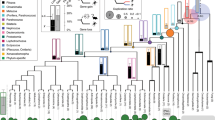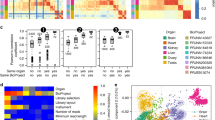Abstract
The observation that animal morphology tends to be conserved during the embryonic phylotypic period (a period of maximal similarity between the species within each animal phylum) led to the proposition that embryogenesis diverges more extensively early and late than in the middle, known as the hourglass model1,2. This pattern of conservation is thought to reflect a major constraint on the evolution of animal body plans3. Despite a wealth of morphological data confirming that there is often remarkable divergence in the early and late embryos of species from the same phylum4,5,6,7, it is not yet known to what extent gene expression evolution, which has a central role in the elaboration of different animal forms8,9, underpins the morphological hourglass pattern. Here we address this question using species-specific microarrays designed from six sequenced Drosophila species separated by up to 40 million years. We quantify divergence at different times during embryogenesis, and show that expression is maximally conserved during the arthropod phylotypic period. By fitting different evolutionary models to each gene, we show that at each time point more than 80% of genes fit best to models incorporating stabilizing selection, and that for genes whose evolutionarily optimal expression level is the same across all species, selective constraint is maximized during the phylotypic period. The genes that conform most to the hourglass pattern are involved in key developmental processes. These results indicate that natural selection acts to conserve patterns of gene expression during mid-embryogenesis, and provide a genome-wide insight into the molecular basis of the hourglass pattern of developmental evolution.
This is a preview of subscription content, access via your institution
Access options
Subscribe to this journal
Receive 51 print issues and online access
$199.00 per year
only $3.90 per issue
Buy this article
- Purchase on Springer Link
- Instant access to full article PDF
Prices may be subject to local taxes which are calculated during checkout



Similar content being viewed by others
Accession codes
Primary accessions
ArrayExpress
Data deposits
The expression data are available for download fromArrayExpress under experiment name ‘hourglass’, accession number E-MTAB-404, and together with the probe sequences at http://publications.mpi-cbg.de/4240-data.
References
Duboule, D. Temporal colinearity and the phylotypic progression: a basis for the stability of a vertebrate Bauplan and the evolution of morphologies through heterochrony. Dev. Suppl. 135–142(1994)
Raff, R. A. The Shape of Life: Genes, Development and the Evolution of Animal Form (Univ Chicago Press, 1996)
Hall, B. K. Phylotypic stage or phantom, is there a highly conserved embryonic stage in vertebrates? Trends Ecol. Evol. 12, 461–463 (1997)
Sander, K. Specification of the basic body plan in insect embryogenesis. Adv. Insect Physiol. 12, 125–238 (1976)
Wray, G. A. & Raff, R. A. Rapid evolution of gastrulation mechanisms in a sea urchin with lecithotrophic larvae. Evolution 45, 1741–1750 (1991)
Goldstein, B., Frisse, L. M. & Thomas, W. K. Embryonic axis specification in nematodes: evolution of the first step in development. Curr. Biol. 8, 157–160 (1998)
Schmidt, K. & Starck, J. M. Developmental variability during early embryonic development of zebra fish, Danio rerio . J. Exp. Zoolog. B 302, 446–457 (2004)
Carroll, S. B. Evolution at two levels: on genes and form. PLoS Biol. 3, e245 (2005)
Wray, G. A. The evolutionary significance of cis-regulatory mutations. Nature Rev. Genet. 8, 206–216 (2007)
von Baer, K. E. Uber Entwickelungsgeschichte der Thiere: Beobachtung und Reflektion (Königsberg, 1828)
Darwin, C. On the Origin of Species (Murray, 1859)
Garstang, W. The theory of recapitulation: a critical restatement of the biogenetic law. Linn. J. Zool 35, 81–101 (1922)
Sander, K. The evolution of patterning mechanisms: gleanings from insect embryogenesis and spermatogenesis. In Development and Evolution 137–159C (Cambridge Univ. Press, 1983)
Galis, F. & Metz, J. A. Testing the vulnerability of the phylotypic stage: on modularity and evolutionary conservation. J. Exp. Zool. 291, 195–204 (2001)
Hazkani-Covo, E., Wool, D. & Graur, D. In search of the vertebrate phylotypic stage: a molecular examination of the developmental hourglass model and von Baer’s third law. J. Exp. Zoolog. B 304, 150–158 (2005)
Davis, J. C., Brandman, O. & Petrov, D. A. Protein evolution in the context of Drosophila development. J. Mol. Evol. 60, 774–785 (2005)
Cruickshank, T. & Wade, M. J. Microevolutionary support for a developmental hourglass: gene expression patterns shape sequence variation and divergence in Drosophila . Evol. Dev. 10, 583–590 (2008)
Richardson, M. K. et al. There is no highly conserved embryonic stage in the vertebrates: implications for current theories of evolution and development. Anat. Embryol. (Berl.) 196, 91–106 (1997)
Bininda-Emonds, O. R. P., Jeffery, J. E. & Richardson, M. K. Inverting the hourglass: quantitative evidence against the phylotypic stage in vertebrate development. Proc. R. Soc. Lond. B 270, 341–346 (2003)
Poe, S. & Wake, M. H. Quantitative tests of general models for the evolution of development. Am. Nat. 164, 415–422 (2004)
Tomancak, P. et al. Global analysis of patterns of gene expression during Drosophila embryogenesis. Genome Biol. 8, R145 (2007)
Zhang, Y., Sturgill, D., Parisi, M., Kumar, S. & Oliver, B. Constraint and turnover in sex-biased gene expression in the genus Drosophila . Nature 450, 233–237 (2007)
Bedford, T. & Hartl, D. L. Optimization of gene expression by natural selection. Proc. Natl Acad. Sci. USA 106, 1133–1138 (2009)
Blomberg, S. P., Garland, T. & Ives, A. R. Testing for phylogenetic signal in comparative data: behavioral traits are more labile. Evolution 57, 717–745 (2003)
Butler, M. A. & King, A. A. Phylogenetic comparative analysis: a modeling approach for adaptive evolution. Am. Nat. 164, 683–695 (2004)
Lemos, B., Meiklejohn, C. D., Cceres, M. & Hartl, D. L. Rates of divergence in gene expression profiles of primates, mice, and flies: stabilizing selection and variability among functional categories. Evolution 59, 126–137 (2005)
Nelson, C. E., Hersh, B. M. & Carroll, S. B. The regulatory content of intergenic DNA shapes genome architecture. Genome Biol. 5, R25 (2004)
Nuzhdin, S. V., Wayne, M. L., Harmon, K. L. & McIntyre, L. M. Common pattern of evolution of gene expression level and protein sequence in Drosophila . Mol. Biol. Evol. 21, 1308–1317 (2004)
Artieri, C. G. & Singh, R. S. Molecular evidence for increased regulatory conservation during metamorphosis, and against deleterious cascading effects of hybrid breakdown in Drosophila . BMC Biol. 8, 26 (2010)
Rifkin, S. A., Kim, J. & White, K. P. Evolution of gene expression in the Drosophila melanogaster subgroup. Nature Genet. 33, 138–144 (2003)
Markow, T. A. & O’Grady, P. M. Drosophila biology in the genomic age. Genetics 177, 1269–1276 (2007)
Ahmed, N., Natarajan, T. & Rao, K. R. Discrete cosine transform. IEEE Trans. Comput. C-23, 90–93 (1974)
Kerr, M. K., Martin, M. & Churchill, G. A. Analysis of variance for gene expression microarray data. J. Comput. Biol. 7, 819–837 (2000)
Smyth, G. K. Limma: linear models for microarray data. In Bioinformatics and Computational Biology Solutions using R and Bioconductor 397–420 (Springer, 2005)
Smyth, G. K. Linear models and empirical Bayes methods for assessing differential expression in microarray experiments. Stat. Appl. Genet. Mol. Biol. 3, Article3 (2004)
Irizarry, R. A. et al. Summaries of Affymetrix GeneChip probe level data. Nucleic Acids Res. 31, e15 (2003)
Jonnalagadda, S. & Srinivasan, R. Principal components analysis based methodology to identify differentially expressed genes in time-course microarray data. BMC Bioinformatics 9, 267 (2008)
Felsenstein, J. PHYLIP—Phylogeny Inference Package (Version 3.2). Cladistics 5, 164–166 (1989)
Huson, D. H. et al. Dendroscope: An interactive viewer for large phylogenetic trees. BMC Bioinformatics 8, 460 (2007)
Heger, A. & Ponting, C. P. Evolutionary rate analyses of orthologs and paralogs from 12 Drosophila genomes. Genome Res. 17, 1837–1849 (2007)
Paradis, E., Claude, J. & Strimmer, K. APE: Analyses of Phylogenetics and Evolution in R language. Bioinformatics 20, 289–290 (2004)
Hansen, T. F. & Martins, E. P. Translating between microevolutionary process and macroevolutionary patterns: the correlation structure of interspecific data. Evolution 50, 1404–1417 (1996)
Suzuki, R. & Shimodaira, H. Pvclust: an R package for assessing the uncertainty in hierarchical clustering. Bioinformatics 22, 1540–1542 (2006)
Ge, Y., Dudoit, S. & Speed, T. P. Resampling-Based Multiple Testing for Microarray Data Analysis. Technical Report (Univ. California, 2003)
Alexa, A., Rahnenfhrer, J. & Lengauer, T. Improved scoring of functional groups from gene expression data by decorrelating GO graph structure. Bioinformatics 22, 1600–1607 (2006)
Grossmann, S., Bauer, S., Robinson, P. N. & Vingron, M. Improved detection of overrepresentation of Gene-Ontology annotations with parent child analysis. Bioinformatics 23, 3024–3031 (2007)
Agudelo-Romero, P. et al. Changes in the gene expression profile of Arabidopsis thaliana after infection with Tobacco etch virus. Virol. J. 5, 92 (2008)
Larracuente, A. M. et al. Evolution of protein-coding genes in Drosophila . Trends Genet. 24, 114–123 (2008)
Smith, C. D., Shu, S., Mungall, C. J. & Karpen, G. H. The Release 5.1 annotation of Drosophila melanogaster heterochromatin. Science 316, 1586–1591 (2007)
Chintapalli, V. R., Wang, J. & Dow, J. A. T. Using FlyAtlas to identify better Drosophila melanogaster models of human disease. Nature Genet. 39, 715–720 (2007)
Acknowledgements
We thank A. Alexa for providing modified code for his topGO R package, A. Larracuente and T. Sackton for sharing data with us, M. Weber for generating the embryo images for Fig. 2, and Carl Zeiss MicroImaging for providing the SPIM microscope. We also thank N. Barton, T. Bedford, D. Hartl, J. Howard, A. Oates and D. Robertson for providing useful comments and discussion on the manuscript. This work was funded by The Human Frontier Science Program (HFSP) Young Investigator’s Grant RGY0084.
Author information
Authors and Affiliations
Contributions
K.M.V. and P.T. conceived the experiment, and K.M.V. and J.J. carried it out. K.M.V., P.T. and S.P. designed the microarray. P.T. conducted the interspecies correlation analysis, and S.P. formulated the linear interpolation algorithm. A.T.K. conceived and conducted the statistical analyses. D.T.G. and C.M.B. conducted the genomic correlates analysis. D.L.C. and U.O. carried out the probe orthology assignments. C.M.B. brought the hourglass concept to the attention of the HFSP team. A.T.K. wrote the paper with support from co-authors.
Corresponding author
Ethics declarations
Competing interests
The authors declare no competing financial interests.
Supplementary information
Supplementary Information
The file contains Supplementary Figures 1-11 with legends, Supplementary Tables 1-11, Supplementary Methods, Supplementary Results, a Supplementary Discussion and Supplementary References. (PDF 4042 kb)
Rights and permissions
About this article
Cite this article
Kalinka, A., Varga, K., Gerrard, D. et al. Gene expression divergence recapitulates the developmental hourglass model. Nature 468, 811–814 (2010). https://doi.org/10.1038/nature09634
Received:
Accepted:
Published:
Issue Date:
DOI: https://doi.org/10.1038/nature09634
This article is cited by
-
A transcriptomic examination of encased rotifer embryos reveals the developmental trajectory leading to long-term dormancy; are they “animal seeds”?
BMC Genomics (2024)
-
Stability in gene expression and body-plan development leads to evolutionary conservation
EvoDevo (2023)
-
The transcriptional legacy of developmental stochasticity
Nature Communications (2023)
-
Lineage-specific, fast-evolving GATA-like gene regulates zygotic gene activation to promote endoderm specification and pattern formation in the Theridiidae spider
BMC Biology (2022)
-
Real age prediction from the transcriptome with RAPToR
Nature Methods (2022)
Comments
By submitting a comment you agree to abide by our Terms and Community Guidelines. If you find something abusive or that does not comply with our terms or guidelines please flag it as inappropriate.



